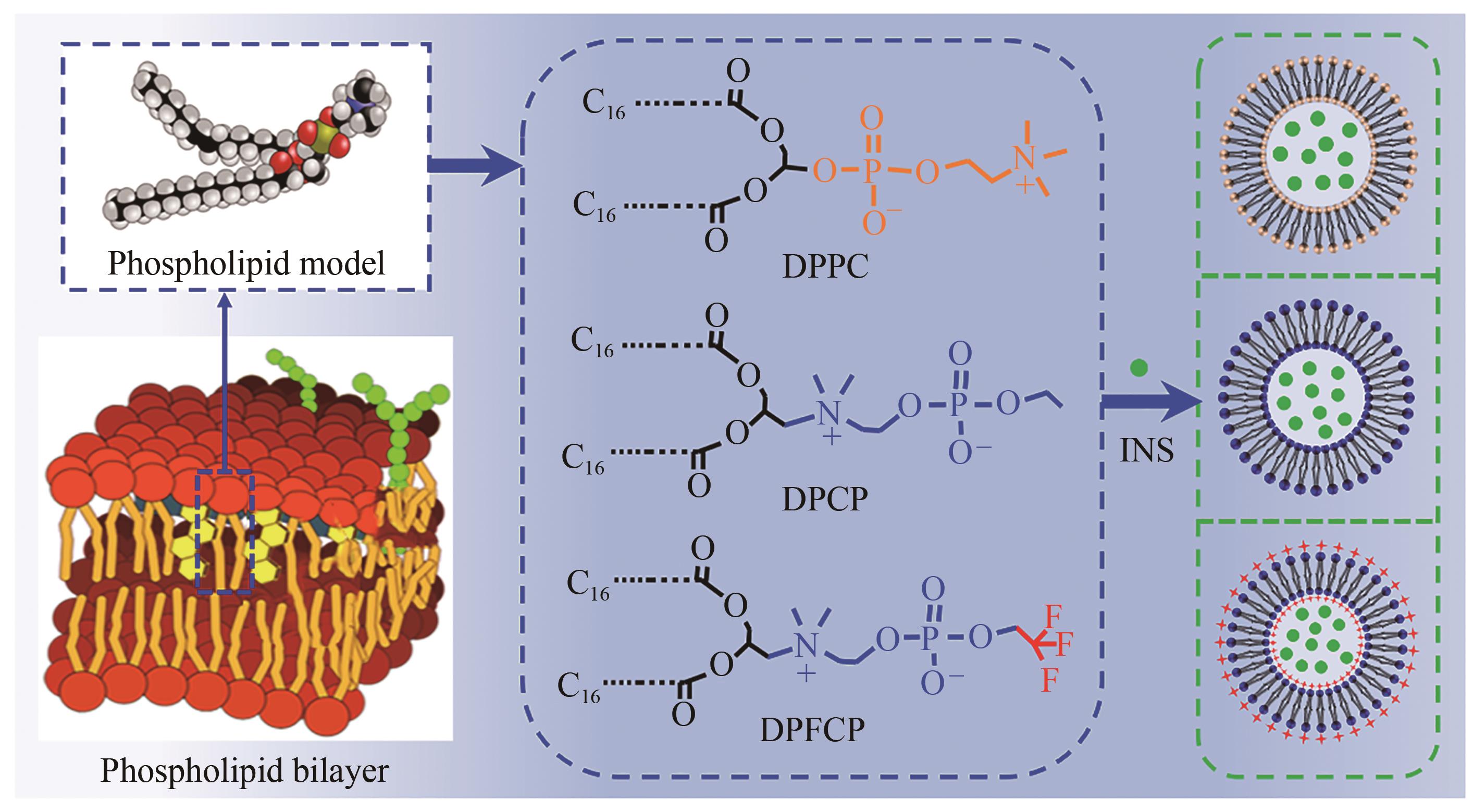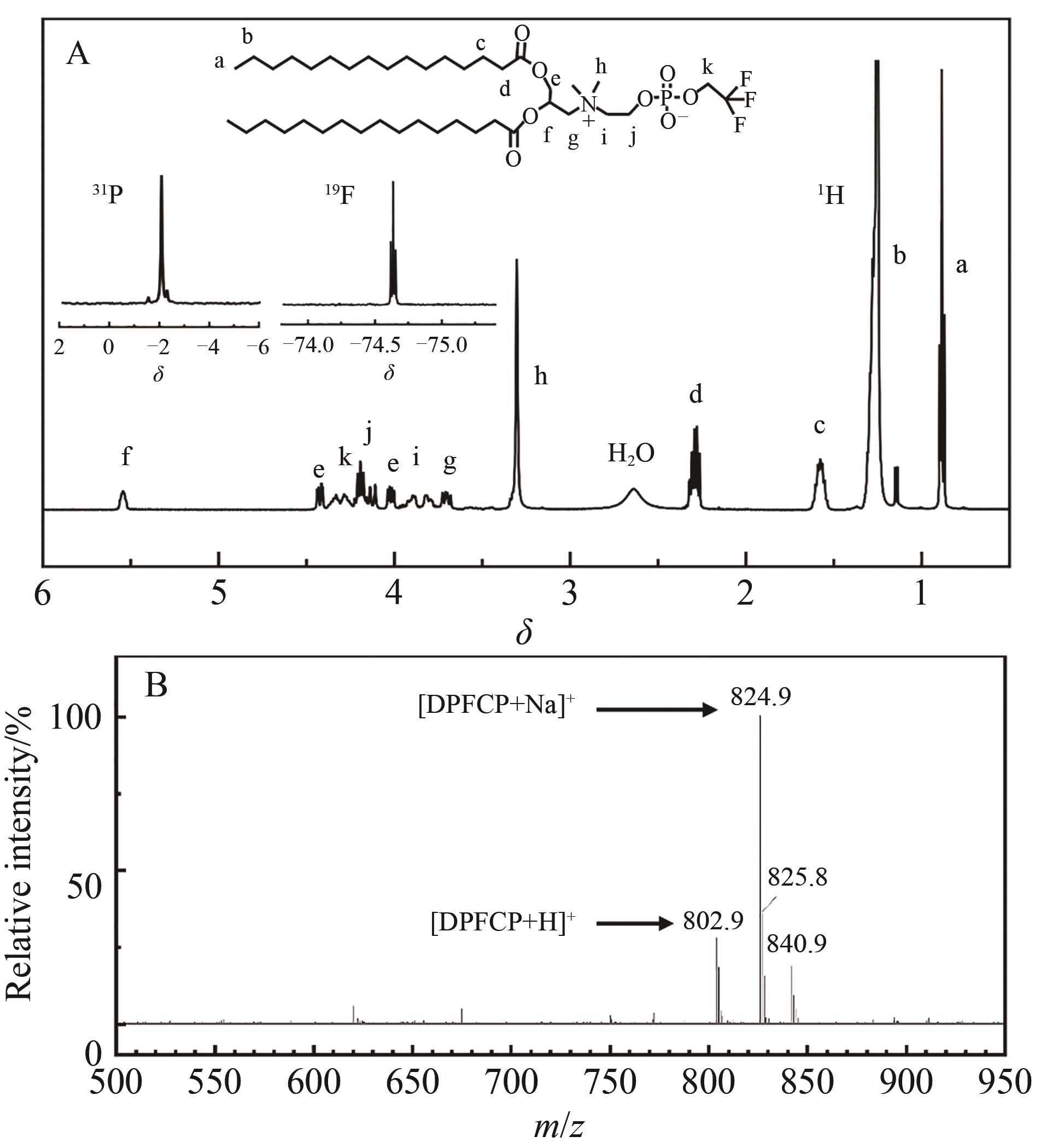
Chinese Journal of Applied Chemistry ›› 2023, Vol. 40 ›› Issue (5): 730-742.DOI: 10.19894/j.issn.1000-0518.220384
• Full Papers • Previous Articles Next Articles
Fluoride-Functionalized Choline Phosphate Liposomes for Oral Insulin Administration
Yuan-Hua ZHANG1,2, Sheng-Ran LI1, Xi-Fei YU1,2( )
)
- 1.State Key Laboratory of Polymer Physics and Chemistry,Changchun Institute of Applied Chemistry,Chinese Academy of Science,Changchun 130022,China
2.University of Science and Technology of China,Hefei 230026,China
-
Received:2022-11-23Accepted:2023-03-27Published:2023-05-01Online:2023-05-26 -
Contact:Xi-Fei YU -
About author:xfyu@ciac.ac.cn
-
Supported by:the National Natural Science Foundation of China(21674109)
CLC Number:
Cite this article
Yuan-Hua ZHANG, Sheng-Ran LI, Xi-Fei YU. Fluoride-Functionalized Choline Phosphate Liposomes for Oral Insulin Administration[J]. Chinese Journal of Applied Chemistry, 2023, 40(5): 730-742.
share this article
Add to citation manager EndNote|Ris|BibTeX
URL: http://yyhx.ciac.jl.cn/EN/10.19894/j.issn.1000-0518.220384
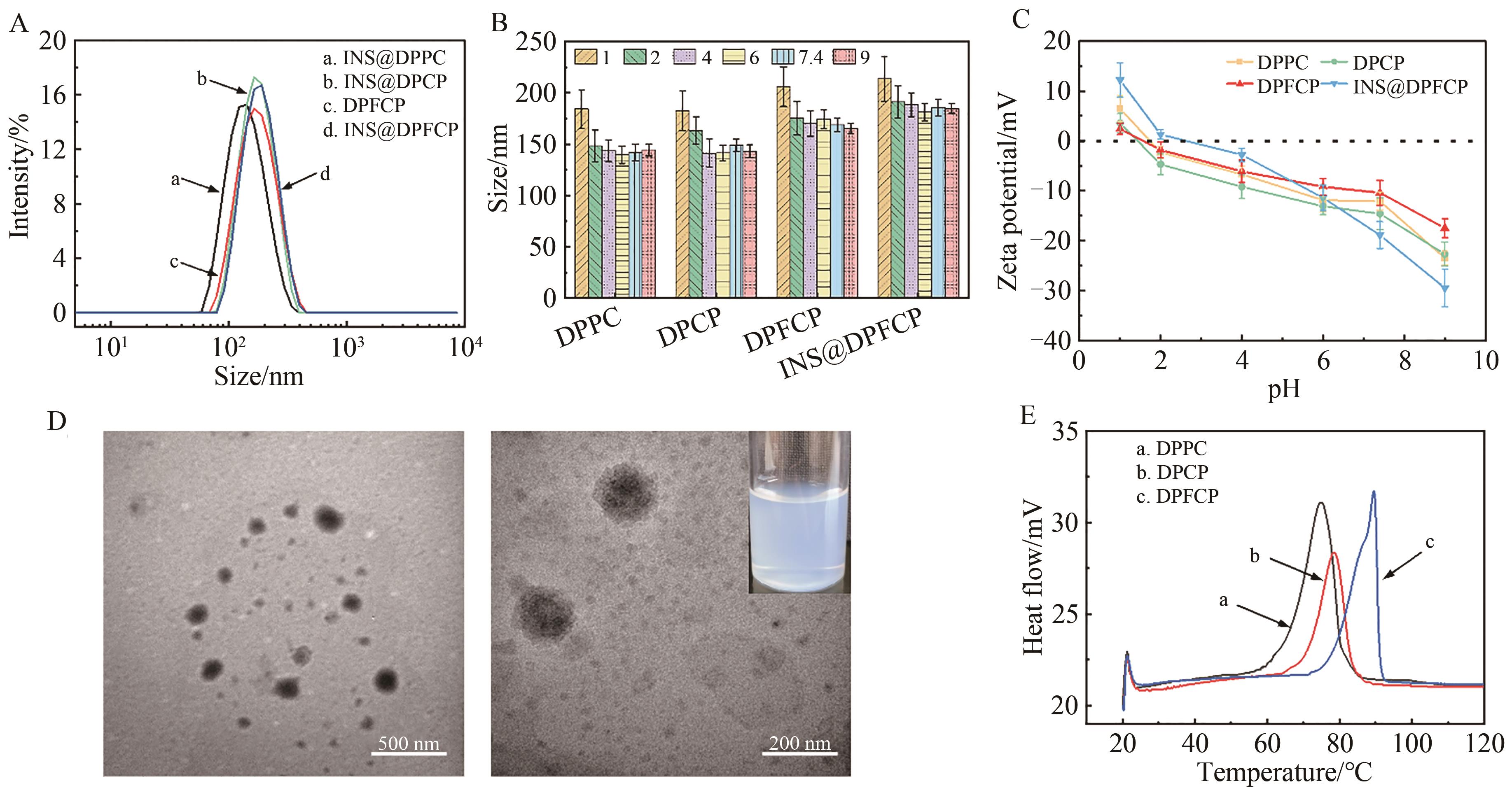
Fig.4 (A) The size distribution (pH=7.4) of INS@DPPC, INS@DPCP, DPFCP and INS@DPFCP liposomes; (B) Size change and (C) Zeta potential change in different pH (1.0, 2.0, 4.0, 6.0, 7.4 and 9.0) solution for 2 h of DPPC, DPCP, DPFCP and INS@DPFCP liposomes; (D) TEM images of INS@DPFCP liposomes; (E) Tm of DPPC, DPCP and DPFCP
| Sample | Size/nm | PDI | DLE/% | DLC/% | |
|---|---|---|---|---|---|
| INS@DPPC | 157 | 0.219 | -22.1±1.8 | 45.2±2.3 | 3.39±0.41 |
| INS@DPCP | 169 | 0.223 | -24.6±1.2 | 42.7±1.2 | 3.2±0.68 |
| DPFCP | 163 | 0.236 | -10.3±2.5 | / | / |
| INS@DPFCP | 185 | 0.247 | -18.9±2.7 | 47.1±3.9 | 3.53±0.35 |
Table 1 The size, PDI, Zeta potential, DLE and DLC of INS@DPPC, INS@DPCP, DPFCP and INS@DPFCP liposomes
| Sample | Size/nm | PDI | DLE/% | DLC/% | |
|---|---|---|---|---|---|
| INS@DPPC | 157 | 0.219 | -22.1±1.8 | 45.2±2.3 | 3.39±0.41 |
| INS@DPCP | 169 | 0.223 | -24.6±1.2 | 42.7±1.2 | 3.2±0.68 |
| DPFCP | 163 | 0.236 | -10.3±2.5 | / | / |
| INS@DPFCP | 185 | 0.247 | -18.9±2.7 | 47.1±3.9 | 3.53±0.35 |
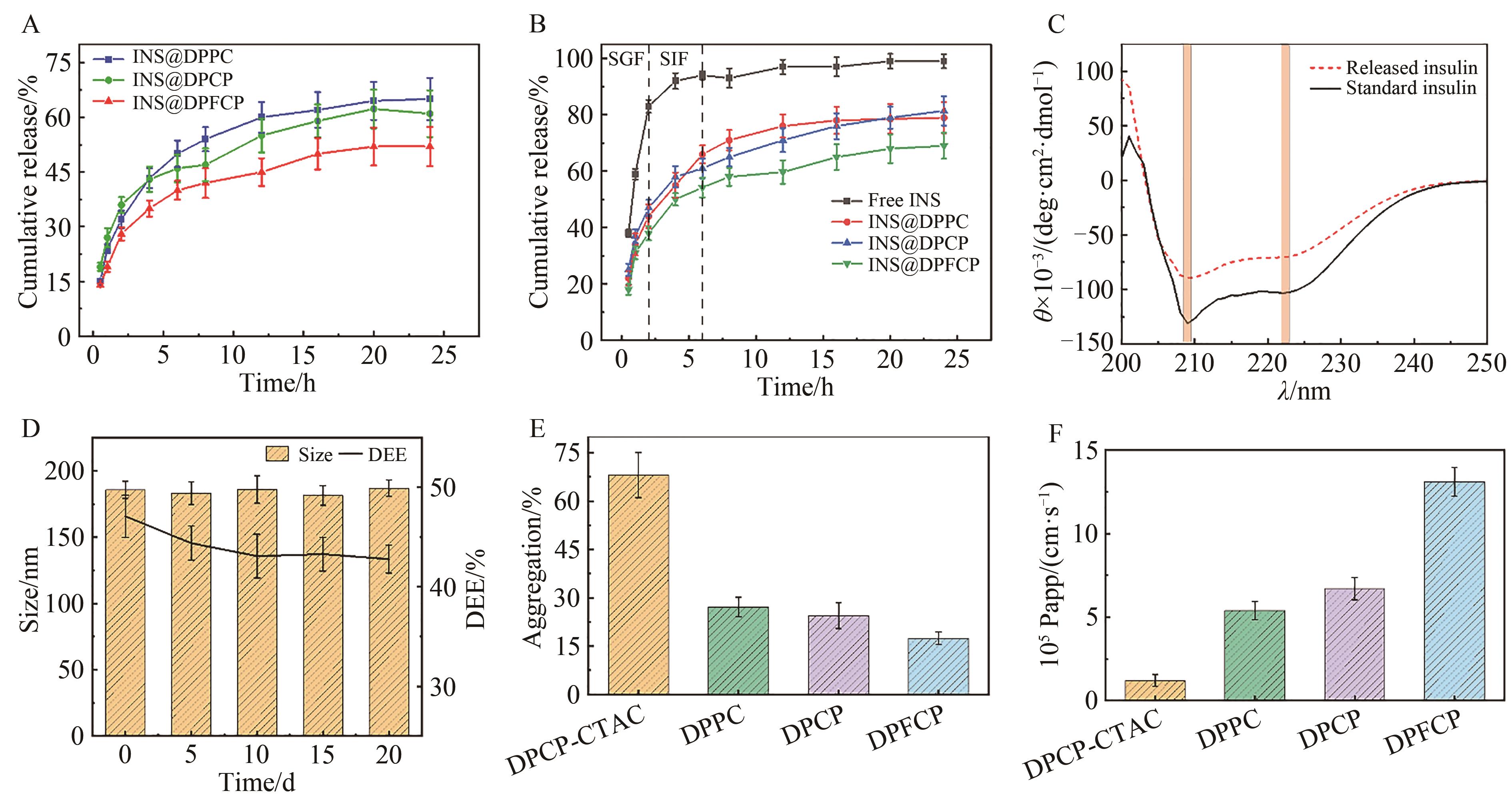
Fig.5 (A) The cumulative release and (B) the enzymatic degradation in SGF(0~2 h) and SIF(2~6 h) of INS@DPPC, INS@DPCP and INS@DPFCP liposomes in PBS buffer solution at 37 ℃; (C) CD curves of standard insulin and released insulin of INS@DPFCP; (D) Changes in size and encapsulation efficiency of INS@DPFCP liposomes at 4 ℃ for 20 d; (E) Aggregation and (F) Papp of DPCP-CTAC, DPPC, DPCP and DPFCP in mucin solution for 2 h
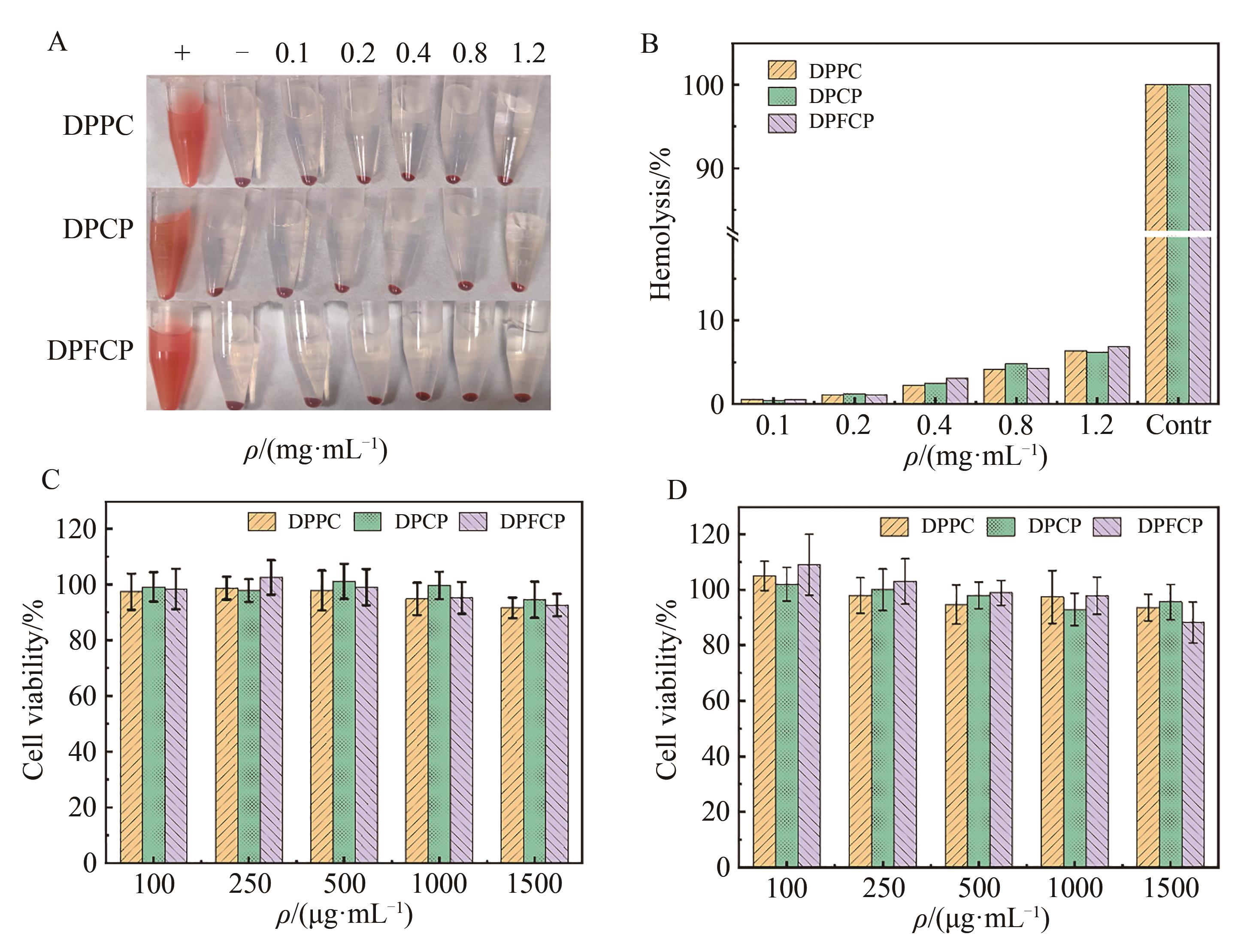
Fig.6 (A, B) Hemolysis of different concentrations of DPPC, DPCP and DPFCP liposomes after 2 h incubation with mouse RBC; The cell viability to Caco-2 cells (C) and NIH-3T3 cells (D) fed by DPPC, DPCP and DPFCP liposomes for 24 h
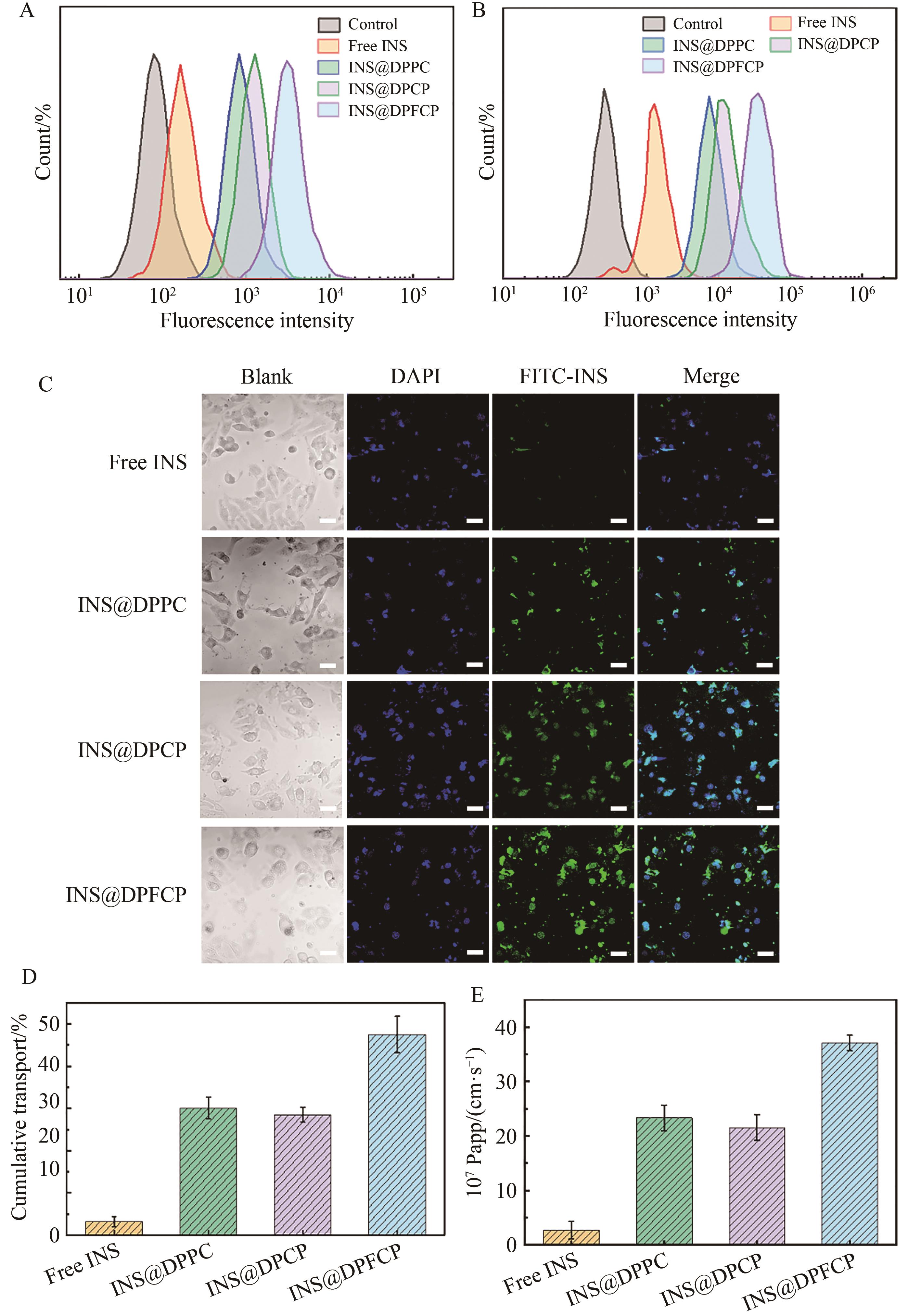
Fig.7 Flow cytometric analysis in treated Caco-2 cells with Free INS, INS@DPPC, INS@DPCP and INS@DPFCP liposomes for (A) 2 h and (B) 4 h, and (C) CLSM images for 4 h, scale bar is 20 μm; (D) The cumulative transport volume and (E) Papp of the monolayer cell membrane model of Caco-2 cells for 4 h
| 1 | HEALD A H, STEDMAN M, DAVIES M, et al. Estimating life years lost to diabetes: outcomes from analysis of national diabetes audit and office of national statistics data[J]. Cardiovasc Endocr Me, 2020, 9(4): 183-185. |
| 2 | SUN H, SAEEDI P, KARURANGA S, et al. IDF diabetes atlas: global, regional and country-level diabetes prevalence estimates for 2021 and projections for 2045[J]. Diabetes Res Clin Pr, 2022, 183: 109119. |
| 3 | XIAO Y F, WANG J Q, LIU C, et al. Oral insulin delivery platforms: strategies to address the biological barriers[J]. Angew Chem Int Ed, 2020, 59(45): 19787-19795. |
| 4 | AMRITA B, KELLY L, TYLER B, et al. Ionic liquids for oral insulin delivery[J]. PNAS, 2018, 115(28): 7296-7301. |
| 5 | Al-REMAWI M, ELSAYED A, MAGHRABI I, et al. Chitosan/lecithin liposomal nanovesicles as an oral insulin delivery system[J]. Pharm Dev Technol, 2016, 22(3): 390-398. |
| 6 | MOROZ E, MATOORI S, LEROUX J C, et al. Oral delivery of macromolecular drugs: where we are after almost 100 years of attempts[J]. Adv Drug Delivery Rev, 2016, 101: 108-121. |
| 7 | ZHU Q G, CHEN Z J, PAUL P K, et al. Oral delivery of proteins and peptides: challenges, status quo and future perspectives[J]. Acta Pharm Sin B, 2021, 11(8): 2416-2448. |
| 8 | 黄琼卫, 赵丽, 宋之明, 等. 葡萄糖敏感苯硼酸基高分子纳米药物传输体系[J]. 应用化学, 2017, 34(7): 733-743. |
| HUANG Q W, ZHAO L, SONG Z M, et al. Phenylboronic acid-based glucose-sensitive polymer nanocarriers used as drug delivery systems[J]. Chin J Appl Chem, 2017, 34(7): 733-743. | |
| 9 | YUN Y, CHO Y W, PARK K. Nanoparticles for oral delivery: targeted nanoparticles with peptidic ligands for oral protein delivery[J]. Adv Drug Delivery Rev, 2013, 65(6): 822-832. |
| 10 | ZUBEN E S V, ELOY J O, ARAUJO V H S, et al. Insulin-loaded liposomes functionalized with cell-penetrating peptides: influence on drug release and permeation through porcine nasal mucosa[J]. Colloids Surf A, 2021, 622: 126624. |
| 11 | JASH A, UBEYITOGULLARI A, RIZVI S S H. Liposomes for oral delivery of protein and peptide-based therapeutics: challenges, formulation strategies, and advances[J]. J Mater Chem B, 2021, 9(24): 4773-4792. |
| 12 | 韩旭, 丁冠宇, 董青, 等. 基于脂质体的纳米基因载体的研究进展[J]. 应用化学, 2018, 35(7): 735-744. |
| HAN X, DING G Y, DONG Q, et al. Research progress of nano-gene carriers based on liposomes[J]. Chin J Appl Chem, 2018, 35(7): 735-744. | |
| 13 | HAN X, LU Y, XIE J, et al. Zwitterionic micelles efficiently deliver oral insulin without opening tight junctions[J]. Nat Nanotechnol, 2020, 15(7): 605-614. |
| 14 | HU W Y, WU Z M, YANG Q Q, et al. Smart pH-responsive polymeric micelles for programmed oral delivery of insulin[J]. Colloids Surf B, 2019, 183: 110443. |
| 15 | ZENG Z Y, QI D M, YANG L, et al. Stimuli-responsive self-assembled dendrimers for oral protein delivery[J]. J Controlled Release, 2019, 315: 206-213. |
| 16 | WEN N, LÜ S Y, GAO C M, et al. Glucose-responsive zwitterionic dialdehyde starch-based micelles with potential anti-phagocytic behavior for insulin delivery[J]. Chem Eng J, 2018, 335: 52-62. |
| 17 | RAO R, LIU X H, LI Y H, et al. Bioinspired zwitterionic polyphosphoester modified porous silicon nanoparticles for efficient oral Insulin delivery[J]. Biomater Sci, 2021, 9(3): 685-699. |
| 18 | LI Y, JI W H, PENG H, et al. Charge-switchable zwitterionic polycarboxybetaine particle as an intestinal permeation enhancer for efficient oral insulin delivery[J]. Theranostics, 2021, 11(9): 4452-4466. |
| 19 | ZHOU Y H, LIU L, CAO Y, et al. A nanocomposite vehicle based on metal-organic framework nanoparticle incorporated biodegradable microspheres for enhanced oral insulin delivery[J]. ACS Appl Mater Interfaces, 2020, 12(20): 22581-22592. |
| 20 | HE M Y, PEI Y, HU Y L, et al. Erythrocyte-membrane-enveloped biomineralized metal-organic framework nanoparticles enable intravenous glucose-responsive insulin delivery[J]. ACS Appl Mater Interfaces, 2021, 13(17): 19648-19659. |
| 21 | LIU L, ZHANG Y, YU S J, et al. pH-and amylase-responsive carboxymethyl starch/poly(2-isobutyl-acrylic acid) hybrid microgels as effective enteric carriers for oral insulin delivery[J]. Biomacromolecules, 2018, 19(6): 2123-2136. |
| 22 | HU Y W, GAO S J, LU H F, et al. Acid-resistant and physiological pH-responsive DNA hydrogel composed of a-motif and i-motif toward oral insulin delivery[J]. J Am Chem Soc, 2022, 144(12): 5461-5470. |
| 23 | HE H S, LU Y, QI J P, et al. Adapting liposomes for oral drug delivery[J]. Acta Pharm Sin B, 2019, 9(1): 36-48. |
| 24 | VITALE A, BONGIOVANNI R, AMEDURI B. Fluorinated oigomers and polymers in photopolymerization[J]. Chem Rev, 2015, 115(16): 8835-8866. |
| 25 | CAO Y, WU H P, ALLEC S I, et al. A highly stretchy, transparent elastomer with the capability to automatically self-heal underwater[J]. Adv Mater, 2018, 30(49): 1804602. |
| 26 | 侯成敏, 李娜, 董海涛, 等. 含氟环氧树脂杂化纳米二氧化硅超疏水材料的制备与性能[J]. 应用化学, 2019, 36(7): 798-806. |
| HOU C M, LI N, DONG H T, et al. Preparation and performance of hybrid superhydrophobic materials from fluorinated epoxy resin and silica nanoparticles[J]. Chin J Appl Chem, 2019, 36(7): 798-806. | |
| 27 | WU P K, ZHANG H T, SUN M L, et al. Manipulating offense and defense signaling to fight cold tumors with carrier-free nanoassembly of fluorinated prodrug and siRNA[J]. Adv Mater, 2022, 34(38): 2203019. |
| 28 | LI G Z, WANG S P, DENG D S, et al. Fluorinated chitosan to enhance transmucosal delivery of sonosensitizer-conjugated catalase for sonodynamic bladder cancer treatment post-intravesical instillation[J]. ACS Nano, 2020, 14(2): 1586-1599. |
| 29 | LI G Z, LEI Q F, WANG F, et al. Fluorinated polymer mediated transmucosal peptide delivery for intravesical instillation therapy of bladder cancer[J]. Small, 2019, 15(25): 1900936. |
| 30 | LI S R, MEI W K, WANG X Z, et al. Choline phosphate lipid insertion and rigidification of cell membranes for targeted cancer chemo-immunotherapy[J]. Chem Commun, 2021, 57: 1372-1375. |
| 31 | WANG W L, JIANG S N, LI S R, et al. Functional choline phosphate lipids for enhanced drug delivery in cancer therapy[J]. Chem Mater, 2021, 33(2): 774-781. |
| 32 | ZHANG X W, QI J P, LU Y, et al. Biotinylated liposomes as potential carriers for the oral delivery of insulin[J]. Nanomed: Nanotechnol Biol Med, 2014, 10(1): 167-176. |
| 33 | NIU M M, LU Y, HOVGAARD L, et al. Hypoglycemic activity and oral bioavailability of insulin-loaded liposomes containing bile salts in rats: the effect of cholate type, particle size and administered dose[J]. Eur J Pharm Biopharm, 2012, 81(2): 265-272. |
| 34 | ZHOU Y H, CHEN Z X, CHEN X S, et al. A pH-triggered self-unpacking capsule containing zwitterionic hydrogel-coated MOF nanoparticles for efficient oral exendin-4 delivery[J]. Adv Mater, 2021, 33(32): 2102044. |
| 35 | WONG C Y, AL-SALAMI H, DASS C R, et al. Recent advancements in oral administration of insulin-loaded liposomal drug delivery systems for diabetes mellitus[J]. Int J Pharmaceut, 2018, 549: 201-217. |
| 36 | ZHU X, WU J, SHAN W, et al. Sub-50 nm nanoparticles with biomimetic surfaces to sequentially overcome the mucosal diffusion barrier and the epithelial absorption barrier[J]. Adv Funct Mater, 2016, 26(16): 2728-2738. |
| 37 | PRESAS E, MCCARTNEY F, SULTAN E, et al. Physicochemical, pharmacokinetic and pharmacodynamic analyses of amphiphilic cyclodextrin-based nanoparticles designed to enhance intestinal delivery of insulin[J]. J Controlled Release, 2018, 286: 402-414. |
| 38 | MAGARKAR A, RÓG T, BUNKER A. Molecular dynamics simulation of inverse-phosphocholine lipids[J]. J Phys Chem C, 2014, 118(33): 19444-19449. |
| 39 | ZHANG C, LIU T Q, WANG W Q, et al. Tuning of the aggregation behavior of fluorinated polymeric nanoparticles for improved therapeutic efficacy[J]. ACS Nano, 2020, 14(6): 7425-7434. |
| 40 | CHEN X Y, CHEN T C, LIN Z F, et al. Choline phosphate functionalized surface: protein-resistant but cell-adhesive zwitterionic surface potential for tissue engineering[J]. Chem Commun, 2015, 51(3): 487-490. |
| [1] | ZHANG Yunhuai1, DONG Xizhe1*, XIAO Peng2, HE Huichao1, LI Xiaoling1. Detection of Insulin by Nickel Nanoparticles Modified Titanium Oxide Nanotube Electrode [J]. Chinese Journal of Applied Chemistry, 2012, 29(08): 948-953. |
| [2] | Chen Ji, Ma Genxiang, Zhang Shugong, Li Deqian, Chen Xi,Nie Yuxiu. The Effect of Ge-132 on Pancreatic Cells of Young Rats in Vitro [J]. Chinese Journal of Applied Chemistry, 1998, 0(4): 74-76. |
| Viewed | ||||||
|
Full text |
|
|||||
|
Abstract |
|
|||||
